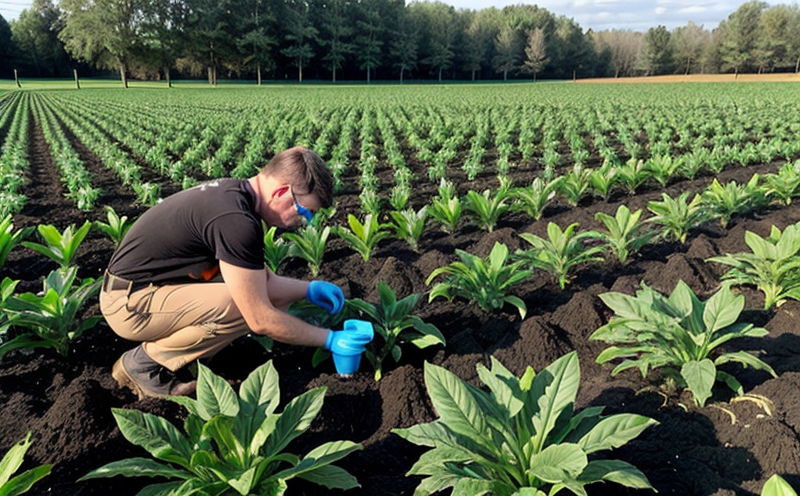Heavy Metal Testing (Lead, Cadmium, Arsenic) in Fertilizers
Heavy metal testing is a critical analytical procedure that ensures fertilizer products meet stringent safety and environmental standards. In agriculture and forestry, the presence of heavy metals such as lead (Pb), cadmium (Cd), and arsenic (As) can pose significant risks to soil quality, crop yield, and human health. These elements are naturally present in the environment but their accumulation in fertilizers due to improper sourcing or manufacturing processes can lead to undesirable consequences. Proper testing helps manufacturers ensure compliance with international standards such as ISO 17025 and EU Directive 2008/99/EC, thereby safeguarding both agricultural productivity and public health.
The process begins with the collection of representative samples from various batches or lots of fertilizers under consideration. The specimens are then carefully prepared by drying, grinding, and homogenizing to ensure accurate analysis. Our laboratory employs state-of-the-art instrumentation like inductively coupled plasma mass spectrometry (ICP-MS) for precise quantification of heavy metals at trace levels.
Compliance with regulations is paramount; thus, our team adheres strictly to accepted methods and guidelines provided by organizations such as ASTM International and European Norms. Our services cover a broad range of fertilizer types including nitrogen fertilizers, phosphate-based products, potassic fertilizers, and blended formulations. Understanding the specific needs of different sectors within agriculture allows us to tailor our testing protocols accordingly.
The importance of heavy metal testing cannot be overstated. It ensures that agricultural inputs do not contribute to soil contamination or water pollution, which could have long-term adverse effects on ecosystems. By conducting thorough analyses, we help protect the environment while promoting sustainable farming practices. This service is essential for maintaining product integrity and reputation among stakeholders in the industry.
Our approach involves not only detecting the presence of harmful substances but also quantifying them accurately so that appropriate corrective measures can be taken if necessary. This proactive stance helps prevent potential issues before they escalate into larger problems. Through our expertise, we contribute to safer agricultural practices globally.
Frequently Asked Questions
Benefits
Ensures adherence to regulatory requirements and enhances brand reputation by demonstrating commitment to product safety.
Promotes sustainable agricultural practices by minimizing environmental impact through the use of clean fertilizers.
Reduces risks associated with contaminated products, protecting consumers from potential health hazards.
Supports continuous improvement initiatives within your organization by providing actionable insights based on test outcomes.
Eurolab Advantages
At Eurolab, our commitment to excellence is reflected in every aspect of our operations. With years of experience and state-of-the-art facilities, we have established ourselves as leaders in providing reliable, accurate, and timely laboratory services.
Accreditation according to ISO 17025 ensures that all tests meet international standards for precision and accuracy.
A highly skilled team of experts with extensive knowledge across various fields within agriculture and forestry.
Access to cutting-edge technology including advanced spectrometric instruments capable of detecting minute amounts of heavy metals.
An unwavering focus on customer satisfaction, ensuring prompt communication throughout the testing process.
We pride ourselves on delivering services that exceed expectations while maintaining a transparent approach to all interactions. Whether you're a small-scale farmer or an international corporation, trust Eurolab to provide dependable solutions tailored specifically for your needs.
Quality and Reliability Assurance
Evaluation of quality assurance in heavy metal testing involves several key aspects including method validation, proficiency testing, and internal audits. Method validation ensures that analytical methods are fit-for-purpose by comparing them against reference materials and established protocols. Proficiency testing allows us to assess the accuracy and consistency of our results through participation in external schemes organized by recognized bodies.
Internal audits serve multiple purposes ranging from monitoring compliance with standard operating procedures to identifying areas for improvement within our workflows. By conducting regular reviews, we ensure that all personnel are up-to-date on current practices and guidelines.
Customer feedback plays a crucial role in shaping our continuous improvement efforts. Regular surveys and direct communications help us understand what matters most to you, enabling us to refine our offerings accordingly. Through these initiatives, we strive to maintain the highest levels of service excellence.





